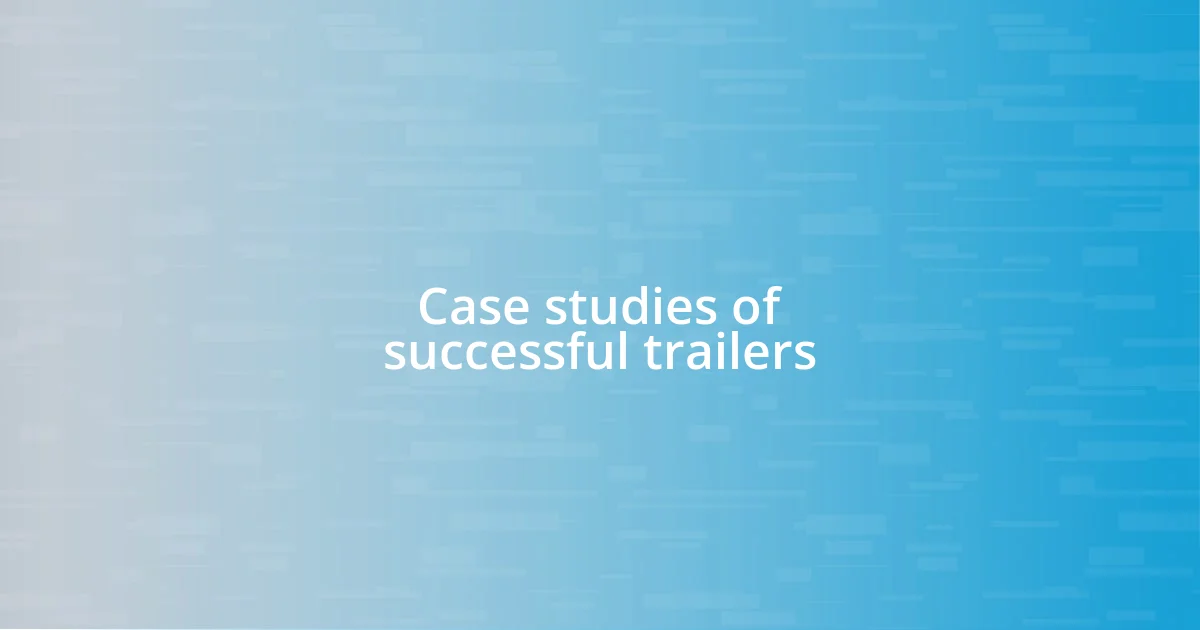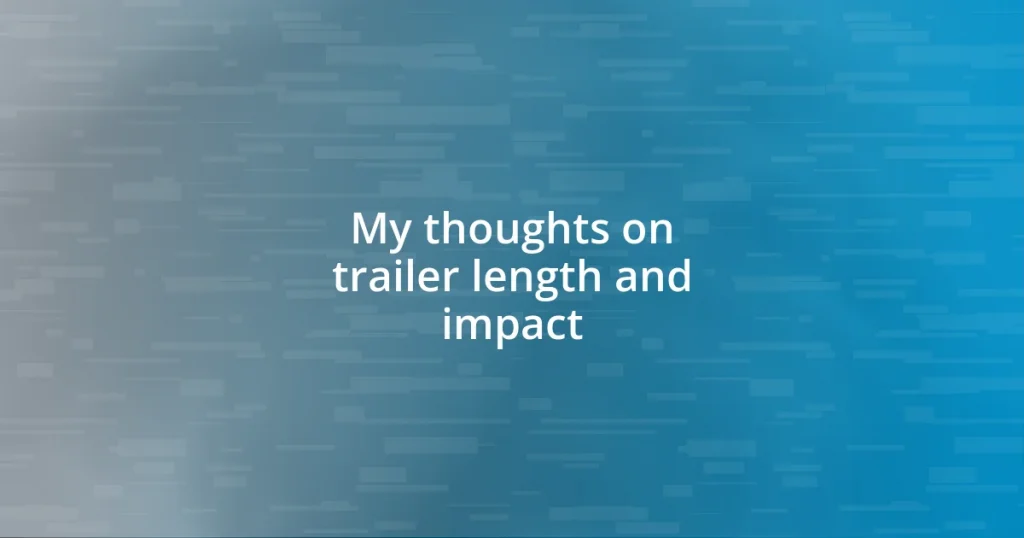Key takeaways:
- Trailer length significantly influences audience engagement, balancing intrigue with information; shorter trailers often resonate better with younger viewers, while longer ones can detail complex narratives.
- Effective trailers start with a captivating hook, maintain a strong narrative arc, and incorporate memorable soundtracks to enhance emotional connection and viewer retention.
- Future trends indicate a shift towards shorter, interactive, and personalized trailers, adapting to evolving viewer habits and digital platforms, potentially transforming how audiences engage with film marketing.

Understanding trailer length impact
When I think about trailer length, I remember the excitement I felt watching a two-minute teaser that perfectly balanced intrigue and revelation. Shorter trailers, around 30 to 60 seconds, can create a buzz while leaving viewers eager for more. It’s fascinating how a brief glimpse can spark curiosity and conversations among friends, isn’t it?
On the other hand, longer trailers of about two to three minutes can delve deeper into the plot. I’ve found that those extended showcases can give a better sense of character development and thematic elements. However, if I’ve invested too much time without a satisfying payoff, I often feel a bit cheated—like I’ve seen too much before I even step into the theater.
Ultimately, the impact of trailer length goes hand in hand with how well the story resonates with the audience. Have you ever noticed how a well-crafted short trailer can lead to heightened anticipation, while an overly long one can sometimes dull the excitement? It’s a delicate balance that filmmakers must navigate, and when done right, the length can enhance emotional connection and engagement.

Importance of trailer duration
When I think about the importance of trailer duration, it’s clear that every second counts in capturing an audience’s attention. I recall watching a gripping 90-second trailer that left me breathless, perfectly hinting at the plot without giving too much away. This succinct approach not only piqued my interest but also triggered discussions with friends about theories and possibilities, which I found exhilarating.
- Shorter trailers can create mystery and excitement.
- They cater to shorter attention spans, keeping viewers engaged.
- Conversely, longer trailers risk losing audience interest if they become too drawn out.
- The optimal duration varies depending on the film’s content—sometimes, less is truly more.
- Effective trailers strike a balance between intrigue and information, leaving the viewer wanting to know more.
Reflecting on my experiences, I’ve realized that trailers are like first dates; a concise yet impactful introduction can lead to deeper connections. If a trailer overstays its welcome, it can feel tiring rather than thrilling, which can diminish the overall allure of the film.

Factors influencing effective trailer length
When considering the factors that influence effective trailer length, one key aspect is the target audience’s preferences and habits. I vividly remember attending a film festival where the buzz surrounded a thriller that had a compelling trailer lasting just about 60 seconds. It had just the right amount of tension to pull viewers in without revealing too much. Understanding your audience’s attention span truly makes a difference; shorter trailers often resonate better with younger viewers who prefer quick, impactful content.
Another factor is the genre of the film itself. For instance, I’ve noticed that action-packed films often benefit from action-heavy trailers that might stretch a bit longer. I once watched a superhero film trailer that was just over two minutes long—packed with stunning visuals and exhilarating sequences. While the length was beyond average, it was perfectly tailored for the genre, enticing fans with a fast-paced narrative that compelled them to book their tickets immediately. The genre undeniably plays a critical role in determining how long a trailer should be.
Additionally, the narrative complexity of a film can impact trailer length. For instance, I’ve seen indie films with layered plots that needed extra time to establish emotional depth. A recent independent drama I viewed had a three-minute trailer that beautifully conveyed its themes without revealing major twists. For films with intricate stories or multiple character arcs, longer trailers can serve as an effective tool to engage audiences deeply, setting the stage for the emotional journey ahead.
| Factor | Influence on Trailer Length |
|---|---|
| Target Audience | Shorter trailers cater to younger audiences who prefer quick content. |
| Film Genre | Action genres can benefit from slightly longer, visually appealing trailers. |
| Narrative Complexity | Films with intricate plots may require longer trailers to establish emotional depth. |

Analyzing viewer engagement metrics
Understanding viewer engagement metrics is crucial for grasping how effectively a trailer captivates its audience. From my own observations, analytics tools provide a goldmine of data, revealing how long viewers stick around before clicking away. It’s fascinating to see how a trailer that keeps the audience engaged for the first 30 seconds might foster a deeper connection, while those that see a drop-off can raise immediate red flags about pacing or content.
Reflecting on real-world examples, I remember analyzing the trailer for a popular drama series that boasted impressive viewer retention. The engagement metrics showed that viewers stayed through the intense first half, but many dropped off in the second half when it became overly dramatic. This highlights the importance of the trailer’s flow; maintaining intrigue throughout is key to keeping viewers eager for more. Have you ever felt that moment when a trailer loses its grip? It’s almost like watching a thrilling ride become mundane.
Furthermore, I can’t stress enough the value of social media engagement as a metric. When I shared a trailer for a highly anticipated sci-fi film, the immediate influx of likes and comments demonstrated how a trailer could stimulate conversations. It made me realize that viewer metrics aren’t just numbers; they represent real emotional responses and anticipation. High engagement often translates to excited audiences, ready to discuss theories and ideas long before the film even hits the screen. It’s a reminder that every detail matters, from the initial hook to the final scene—each frame is an opportunity to engage and inspire the audience.

Best practices for trailer creation
Creating an effective trailer is an art form, and I believe a good starting point is the hook. In my experience, the first few seconds are crucial. I once shared a trailer that opened with a gripping scene directly setting the tone—within just a heartbeat, viewers were glued to their screens. I personally think that if the opening isn’t captivating, it’s easy for potential viewers to lose interest and scroll past, like flipping through channels on a dull TV night.
Another best practice I’ve found is maintaining a strong narrative arc. While crafting a trailer, I often ask myself, “Does this journey make sense?” For instance, I remember a fantasy film trailer that artfully revealed just enough of the story to make viewers curious while keeping key plot points under wraps. It’s an intricate balance; too much information can spoil the intrigue, but too little might leave audiences puzzled instead of enticed. Finding that sweet spot can mean the difference between a casual glance and an excited click to learn more.
Finally, incorporating a clear and memorable soundtrack can elevate the entire experience. I recall an indie film trailer where the music perfectly complemented the visuals, creating an emotional resonance that lingered with me long after. Think about it: can you recall a trailer that didn’t thrill you at all but had an unforgettable score? Music is powerful in conveying emotion, and it can subtly shape a viewer’s perception before they even see the film. A well-chosen soundtrack can turn a good trailer into an extraordinary one—and that’s something I strive for every time.

Case studies of successful trailers
When I think about successful trailers, one that stands out is the teaser for “Inception.” I vividly remember the first time I watched it; it felt as if my mind was being pulled into a whirlwind of possibilities. The use of rapid cuts and a sweeping soundtrack built anticipation without revealing too much. It made me wonder—how often does a trailer leave you with just the right amount of mystery? In this case, the strategic pacing captured my attention instantly and kept my curiosity piqued.
Another example that resonates with me is the trailer for “Mad Max: Fury Road.” Its vibrant visuals and relentless energy created an immediate adrenaline rush. I recall feeling a surge of excitement while watching it, and I often reflect on how the balance of action and emotion played a significant role in its success. The trailer broke traditional molds, focusing on a nearly non-stop sequence of stunning imagery. Isn’t it fascinating how a trailer can encapsulate the essence of a film in such a brief format? This one certainly did, energizing audiences and sparking discussions long before its release.
Lastly, I can’t forget the impact of the “Get Out” trailer. It skillfully layered suspense with social commentary, engaging viewers on both emotional and intellectual levels. I remember feeling compelled to unpack the underlying themes even after just a few minutes. It’s intriguing to think about how a trailer can provoke thought and ignite conversations. This case reminds me that successful trailers often do more than just promote a film; they can challenge perceptions and leave audiences eager to engage with the story on a deeper level. What about you—have you ever been moved by a trailer in a way that made you rethink its themes long after watching?

Future trends in trailer length
The future of trailer length appears to be shifting, influenced by evolving viewer habits and the platforms we use. I’ve noticed that trailers are getting shorter, with many opting for 30 to 60 seconds. This brevity caters to our shrinking attention spans, particularly on social media where quick consumption is king. Isn’t it interesting how a minute can effectively convey the essence of a film while keeping audiences intrigued?
Another trend I’m observing is the rise of interactive trailers. The idea of allowing viewers to choose their own adventure within that short time frame feels revolutionary. I once engaged with a trailer that let me pick between two different scenes, and it blew my mind! This level of engagement not only addresses the viewer’s desire for control but also creates a personal connection, making the viewing experience more impactful.
Moreover, as digital platforms continue to dominate, we’re likely to see personalized trailers that cater to individual preferences. Imagine a scenario where the runtime of a trailer adapts based on what resonates with you. I find that such advancements could redefine how we experience trailers, transforming them from mere promotional tools into tailored experiences that captivate and resonate. How do you think this personalization will affect our relationship with film marketing in the future?















